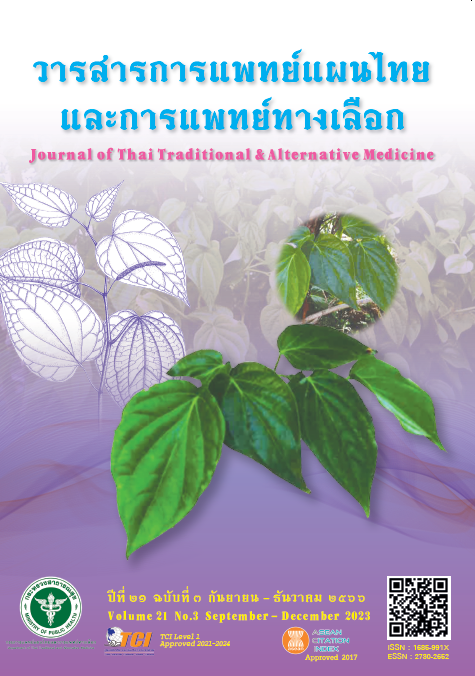Antibacterial and Antioxidant Activities of Shallot (Allium ascalonicum) Extract in Lablae District, Uttaradit Province
Main Article Content
Abstract
Introduction and objective: Shallot (Allium ascalonicum L.) is an economic crop in Uttaradit province. It is an herb that has important compounds and antioxidant properties as well as anti-inflammatory and antibacterial effects. This experimental research aimed to investigate the antibacterial and antioxidant activities of shallot extract in Uttaradit’s Lablae district.
Methods: Shallot samples were collected from Lablae district for the study of their botanical characteristics and quality. Shallot extraction was undertaken with such solvents as water, ethanol and methanol. The crude extracts were analyzed for the amounts of phenolic compounds and quercetin, and tested for antioxidant and antibacterial activities.
Results: The percent yields of shallot extracts from water, ethanol and methanol extraction were 9.07%, 8.86% and 11.53%, respectively; and the amounts of phenolic compounds obtained were 33.67, 41.29 and 13.67 mg/mL, respectively. The yields of quercetin were 0.10±0.01, 0.08±0.01 and 0.14±0.01 %w/w of DW, respectively, while the percent inhibitions (DPPH scavenging activity) were 64.09%, 41.53% and 60.89%, respectively. The analysis of the minimum inhibitory concentration (MIC) and minimum bactericidal concentration (MBC) showed that the water shallot extract had the best antibacterial activity with MIC and MBC for S. aureus DMST at 10 and 10 mg/mL, S. epidermidis DMST 15505 at 2.5 and 2.5 mg/mL and B. cereus DMST 5040 at 5 and 5 mg/mL, respectively.
Discussion: The water shallot extract had the best activity against gram-positive bacteria found on the human skin and the best antioxidant activity that may be attributed to compounds other than phenolic compounds and flavonoids. Although they are present in small quantities, such additional compounds may contribute to enhancing the antioxidant properties.
Conclusion and recommendation: Shallot extract had antioxidant properties and antibacterial activity against S. aureus, S. epidermidis, and B. cereus. This knowledge can be utilized for further development of herbal products with an additional value for shallots from Uttaradit province.
Article Details

This work is licensed under a Creative Commons Attribution-NonCommercial-NoDerivatives 4.0 International License.
References
Siramon P, Waeonukul R. Chemical composition and antibacterial activites of rhizome extract from Curcuma aromatica Salisb. Journal of Science and Technology. 2021;6(2):118-25. (in Thai)
Charoenchai L. Development of Allium ascalonicum L. for cosmeceutical and spa products. Pathum Thani: Agricultural Research Development Agency (Public Organization) Faculty of Pharmaceutical Sciences, Rangsit University; 2017. 125 p. (in Thai)
Mekvimol T, Poonthong G, Chaipunna C, Pumipuntu N. Antimicrobial activity of marigold (Tagetes erecta), mulberry (Morus indica), and red shallot (Allium ascalonicum) extracts against Streptococcus agalactiae. International Journal of One Health. 2020;6(1):56-60.
Faculty of Pharmacy, Ubon Ratchathani University. Shallots. [Internet].2017 [cited 2021 Oct 1]; Available from: http://www. thaicudedrug.com/main.php? action=viewpage&pid=145. (in Thai)
Somkhow P, Junlatat J, Chalomphong N, Prasert T, Mulateeka P. The efficacy of acne gel containing Allium ascalonicum L. extracts. Journal of Traditional Thai Medical Research. 2022;8(2):99-110. (in Thai)
Prakash D, Singh B.N, Upadhyay G. Antioxidant and free radical scavenging activities of phenols from onion (Allium cepa). Food Chemistry. 2007;102(4):1389–93.
Charoenchai L, Pathompak P, Phetmanee T, Meksuriyen D. Relationships between chemical compositions of shallot extracts and antioxidant activity. RSU International Research Conference 2017; 28 Apr 2017; Rangsit University. 2017. p. 97-104.
Office of Agricultural Economics, Ministry of Agriculture and Cooperatives. Shallots: Cultivation area harvested area and productivity per rai, by province, year 2021. [Internet]. [cited 2023 Mar 1]; Available from: https://www.oae.go.th/assets/portals/1/fileups/prcaidata/files/shallot%20percent%2064.pdf (in Thai)
Uttaradit Provincial Agricultural Office. Economic crop information. [Internet]. [cited 2023 Mar 1]; Available from: https://mis-app.uttaradit.doae.go.th/product. (in Thai)
Thitilertdecha N, Teerawutgulrag A, Rakariyatham N. Antioxidant and antibacterial activities of Nephelium lappaceum L. extracts. LWT-Food Science and Technology. 2008;41(10):2029-35.
D’Mello P.M, Joshi J.U, Shetgiri P.P, Dasgupta T.K, Darji K.K. A simple HPLC method for quantitation of quercetin in herbal extracts. J. AOAC Int. 2011;94:100-5.
Clinical and laboratory Standards Institute (CLSI). Methods for dilution antimicrobial susceptibility tests for bacterial that grow aerobically; Approved Standards 7th Edition. Clinical and laboratory Standards Institute document M7-A7. Pennsylvania USA: Clinical and Laboratory Institute; 2009.
Ministry of Public Health. Thai Herbal Pharmacopoeia. Bangkok: The Agricultural Co-operative Federation of Thailand; 2016. (in Thai)
Sawanwong T, Wachirawongsakorn P. Assessment of heavy metal contamination in soil and shallot samples from shallot farming of Tambon Bantuek, Srisatchanalai District, Sukhothai. [Proceedings]. The 4th Science Research Conference; 2012 Mar 12-13; Faculty of Science, Naresuan University. (in Thai)
Pansathern S, Wachirawongsakorn P. Assessment of heavy metal contamination in shallots from fresh markets a case study: Lower North province of Thailand. [Proceedings]. The 7th Rambhai Barni Research National Academic Conference: Local Preparation for ASEAN; 2013 Dec 19-20; Rambhai Barni Rajabhat University. Bangkok: p. 439-42 (in Thai)
Assatarakul K, Himasuttidach N. Antioxidant and antibacterial activities of onion extract and applications in mixed fruit and vegetable juice. Journal of Food Technology, Siam University. 2017;12(1):71-83. (in Thai)


